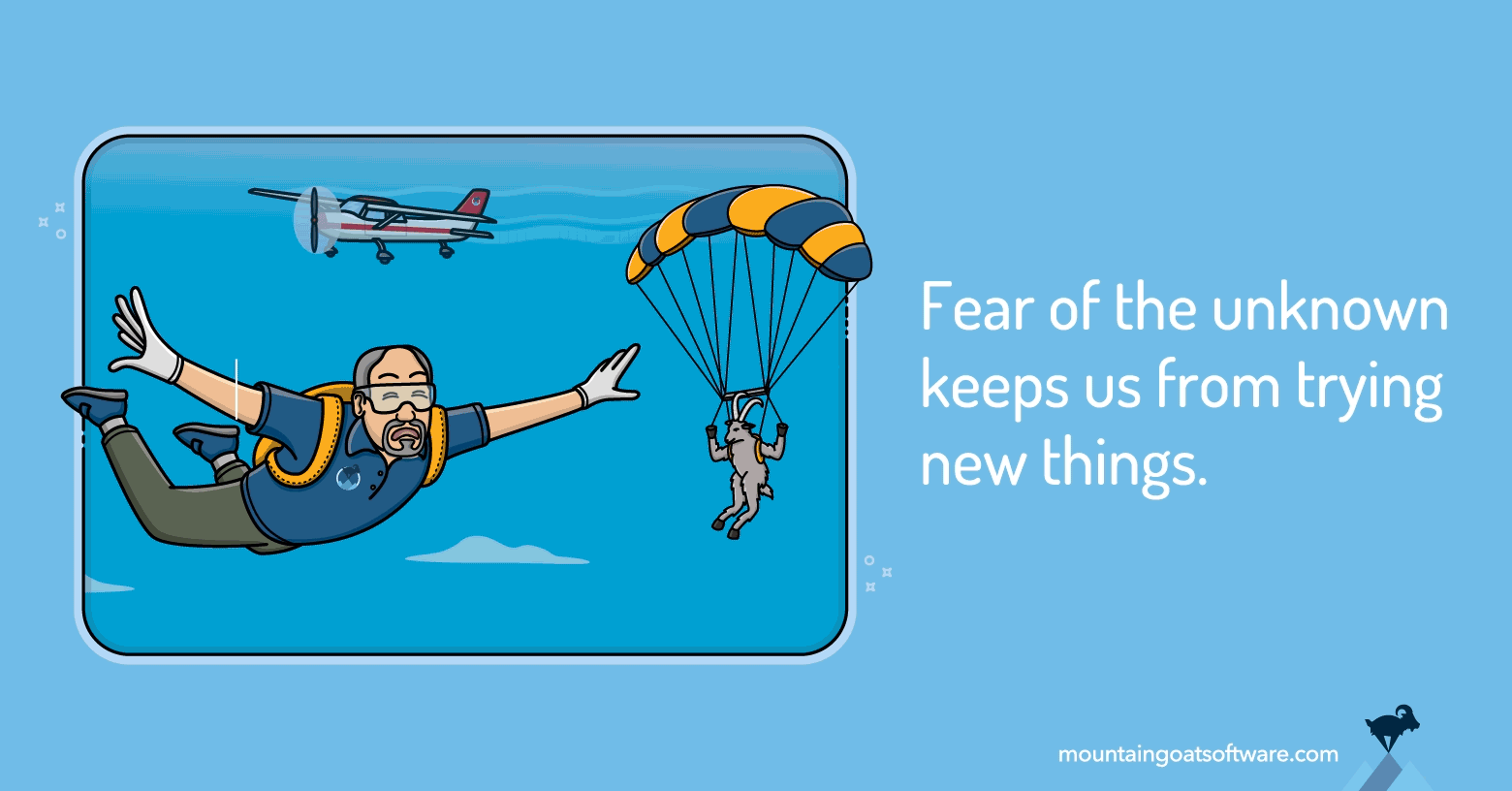A transition to Scrum or an agile way of working can bring great benefits but also great upheaval. And, as with any change, some people will balk, drag their feet, or actively oppose a new way of doing things.
The reasons for resistance to adopting agile and Scrum are as varied as the individuals involved. (I wrote about some of the most common fears people have when facing the transition to Scrum in Five Scary Things about Adopting Agile.)
Whatever the fear, and however it manifests inside your organization, you must understand it to overcome it.
4 Reasons Your Team Might Be Resistant to Change
It’s easy to observe that people are resistant to organizational change. If you’ve worked in an organization for more than a brief period, you’ve probably been resistant to change yourself.
Perhaps you were told you’d have a new manager, or that your team would be using a new technology, or your company was being acquired. Maybe your team had grown in size and was being split into two teams.
Reason 1: Lack of Awareness about Why
The most common reason people resist change is a lack of awareness about the reasons for the change. If your team is being split into two teams, you’re much more likely to support that change if you understand why it’s happening.
Reason 2: Lack of Information about What
Another reason employees resist change is a fear of the unknown. I might be willing to go skydiving one day. (My friends would tell you there’s no way I’d ever do that, and I tend to agree. But for the sake of argument, let’s pretend I’d agreed to give skydiving a try.)
When it’s time to jump out of the airplane, I’ll be a lot more inclined to go through with it if an instructor has removed the fear of the unknown by telling me exactly what to expect.
Whatever the fear, and however it manifests inside your organization, you must understand it to overcome it.
Reason 3: Lack of Job Security
The third most common reason employees resist change is a lack of job security. I’ve got bills to pay and mouths to feed. Will I still have a job after the change? If a change is introduced and I’m worried it could affect my job, I’m probably going to resist that change.
Reason 4: Lack of Executive Advocacy
Finally, the fourth most common reason employees resist change is a lack of executive sponsorship for the change. We’re all much more likely to support a change if there is at least one key leader advocating for the change.
Leaders Resist Change, Too
Managers resist change for slightly different reasons. They are:
- Fear of losing control and authority
- Lack of time
- Comfort with the status quo
- No answer to “What’s in it for me?”
- Not involved in designing the change
I think these reasons managers resist change are informative because each also applies to Scrum Masters, product owners, coaches, architects, lead developers, or others with some added authority or influence.
3 Requirements for Change: Awareness, Desire & Ability
Let’s take a look at strategies you can use to overcome these types of resistance, especially resistance to adopting or improving at agile. In combination, the strategies are designed to convert resistors to advocates by progressing through a sequence of stages needed to make any change.
First, people need to have an awareness that there is a better approach than what they are currently doing. Second, they need the desire to use that approach. And once desire exists, people need the ability to use the new approach.
To change, people must possess awareness, desire, and ability.
Suppose I have recently learned that vegetables from a home garden taste better than store-bought vegetables. That’s the first step: awareness.
Next, I need the desire to start growing my own vegetables. It sounds good, but it’s so much work, and buying vegetables at the store is so easy. That’s why right now, I don’t grow my own vegetables even though I know they taste better. I’m stuck at the desire step.
Once I get past that hang-up and I desire growing vegetables, I will need the ability to grow them. I will need to know how much to water them, which should be planted in the most sunlight, and so on.
The three steps then are me becoming aware homegrown vegetables taste better, then me desiring to take the effort to grow them, and finally having the ability to do so.
3 Strategies for Overcoming Resistance to Change
When someone is resistant, take a moment to think about these three stages and see if you can figure out where the person is stuck. Are they aware there’s a better way? Do they know there’s a better way but just do not desire to do it? Or is desire present but the person doesn’t have the ability?
Where someone is stuck will help you know what to do to reduce their resistance.
Where someone is stuck will help you know what to do to reduce their resistance. And for that, you have 3 strategies to lean on: Building Awareness, Increasing Desire, or Developing Ability.
Strategy 1: Building Awareness
If someone is stuck at the awareness stage, there are a number of things you can do.
Highlight the Problem
First, be sure to communicate that a problem exists. Be clear what will happen if the problem is not addressed. Is a product at risk of being canceled? Is it losing market share to a new competitor? At this point you want to sell the problem, not a specific solution to the problem.
To persuade resistors that a problem exists, use metrics when possible. Instead of saying your product has lost market share, quantify it.
Personalize the Solution
Also consider exposing resistors to new people and experiences. Take them to one of the annual agile or Scrum conferences. Let them meet people who have successfully made the changes you’re introducing.
Are there people in your organization who are further along with agile you can introduce them to?
Focus on One Compelling Reason
I want to share a little tip about persuasion. Don’t try to convince people with a list of benefits. If you tell me there are four reasons I should make a change I don’t want to make, I’m going to pick the weakest of your four points and argue about it. My argument may not convince you, but I’ll convince myself that I’ve parried that point. And with one less point in favor of the change you want to make, I’ll also convince myself I can continue resisting.
So, don’t try to persuade someone with a list of reasons agile is better than what you’re doing today. Instead, focus on one compelling reason.
Strategy 2: Increasing Desire
Let’s move on to looking at resistance because of a lack of desire. These individuals are aware there is a better way, they simply don’t want to do it.
We saw some reasons for a lack of desire in the lists I gave earlier. Someone may be worried about their job. A leader may fear a loss of control or authority. And resistance increases when there’s no good answer to ‘What’s in it for me?’
Fortunately, there are a number of things you can do to increase desire.
Create a Sense of Urgency
The most important is to communicate the why behind the change, creating a sense of urgency. If our product is losing 10% of sales per quarter I’m a lot more willing to make changes than if we’re losing only 1% a year.
To return to my example of learning that homegrown vegetables taste best, suppose you also inform me that they’re much more healthful. That will help give me the desire to start my own garden.
Build Momentum by Focusing on Supporters
Sometimes you can persuade resistors by shifting your attention away from them. Focus instead on those who are engaged in and enthusiastic about the transition to agile. Use their desire to build momentum, since enthusiasm is contagious. If you can make the change seem inevitable that will often reduce resistance.
Address Fears Head On
Our list of reasons for resistance showed that some are due to fear. Address these fears. Have private conversations with resistors and ask what their concerns are. Never be dismissive of fear and never promise what you cannot, but see if you can alleviate fear.
To address concerns about what’s in it for me, talk with resistors about the opportunities agile could bring to their worlds. Paint the picture that while the future is unwritten, it will bring opportunities to those who notice them.
Strategy 3: Developing Ability
Increasing someone’s desire to change, often by increasing the urgency of the need for that change, will move someone to the third step: having the ability to do what is needed in the new way of working.
Invest in Training
If you have a resistor stuck at the ability stage, one of the best things is to provide training and coaching for the person. Think of the better results from my new vegetable garden if a master gardener is there to coach me through it.
A lot of individuals and teams that we work with are in this category. They have the awareness and desire to change, they just need to acquire new skills to be agile.
Create Opportunities to Share Learning
Another strategy is to create ways for team members to share information with each other. I remember working with a team that was really struggling with how to incorporate automated testing into a website that had been in place for years and had been developed with no eye toward automation.
Adding automated unit tests was a real challenge, and I remember the day one of the developers started the morning by announcing that he had some epiphanies the night before and had written 20 unit tests. This was an amazing breakthrough for a team that had managed one automated test the entire previous sprint.
The developer who figured this out shared how he’d done it and you could tell lightbulbs were going off for the other developers.
Create a Safe Environment
Finally, create a safe environment for team members to just do it. Many people have a tendency to hesitate and overthink. (I’d certainly hesitate and overthink just before jumping out the plane door if I ever did go skydiving, which as I mentioned earlier, is highly unlikely!)
When team members are practicing a new skill, ensure they know you will value the effort more than the results. Their efforts at learning new skills should be considered experiments or trials. More important than succeeding at the new skill is trying until they do.
I always think it’s useful to set realistic goals. Try to manage expectations of how much a team can accomplish in its early sprints.
Overcome Resistance the Agile Way
Agile can teach us a lot about overcoming resistance. Use agile to attack resistance iteratively and incrementally and you’ll succeed.
How have you overcome resistance among any of your colleagues? Please share your tips and experiences in the comments. I read and value every comment.









